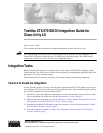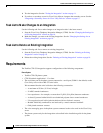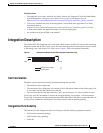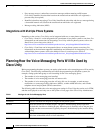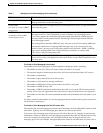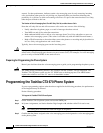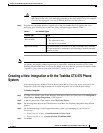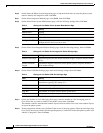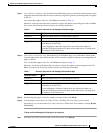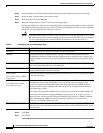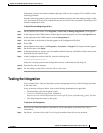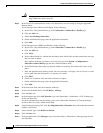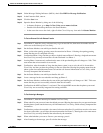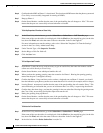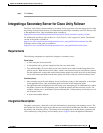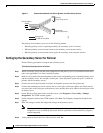
7
Toshiba CTX 670 SMDI Integration Guide for Cisco Unity 4.0
OL-4404-07
Toshiba CTX 670 SMDI Integration Guide for Cisco Unity 4.0
Creating a New Integration with the Toshiba CTX 670 Phone System
Caution In programming the phone system, do not send calls to voice messaging ports in Cisco Unity
that cannot answercalls (voice messagingports that are notset to Answer Calls).For example,
if a voice messaging port is set only to Dialout MWI, do not send calls to it.
Step 4 Program each subscriber phone to forward calls to the pilot number that is assigned to the voice
messaging ports, based on one of the Cisco Unity call transfer types shown in Table 2.
Note You can use alternate extensions to create multiple line appearances, enable easy message access from
cell phones, and simplify addressing messages to subscribers at different locations in Cisco Unity.
Enabling alternate MWIs lets Cisco Unity turn MWIs on at more than one extension. For details, see the
“Appendix: Using Alternate Extensions and MWIs” section on page 19.
Creating a New Integration with the Toshiba CTX 670 Phone
System
After ensuring that the Toshiba CTX 670 phone system and the Cisco Unity server are ready for the
integration, do the following procedures to set up the integration and to enter the port settings.
To Create an Integration
Step 1 If UTIM is not already open, on the Windows Start menu of the Cisco Unity server, click Programs >
Cisco Unity > Manage Integrations. UTIM appears.
Step 2 In the left pane of the UTIM window, click Cisco Unity Server.
Step 3 On the Integration menu of the UTIM window, click New. The Telephony Integration Setup Wizard
appears.
Step 4 On the Welcome page, click the applicable phone system type, depending on your version of
Cisco Unity:
• Cisco Unity 4.2 or later—Circuit-Switched via Voice Cards
• Cisco Unity 4.0 or 4.1—Circuit-Switched (Traditional PBX)
Step 5 Click Next.
Table 2 Call Transfer Types
Transfer Type Usage
Release transfer
(blind transfer)
Program the phone to forward calls to the pilot number when:
• The extension is busy
• The call is not answered
Supervised transfer Program the phone to forward calls to the pilot number only when the
call is not answered. Confirm that call forwarding is disabled when the
extension is busy.



